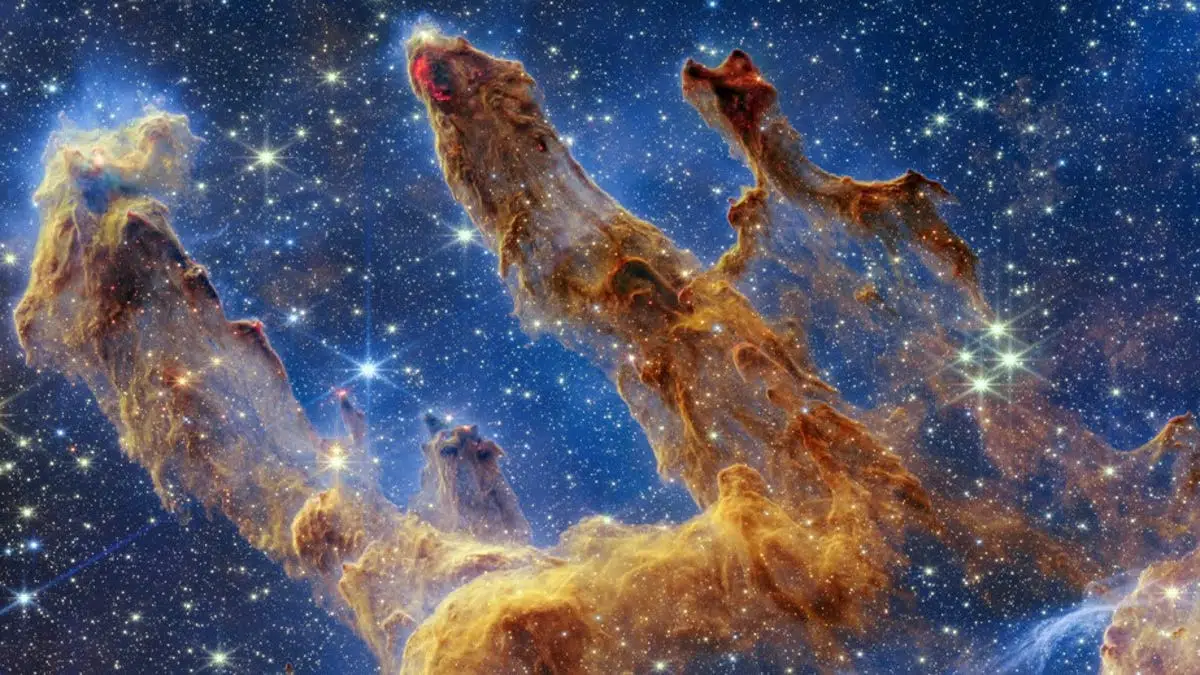
A stunning photograph of the “Pillars of Creation” has been captured by NASA’s James Webb Space Telescope. The image captured in a Near-Infrared Camera (NIRCam) depicts new protostars forming within dense clouds of gas and dust.
The protostars are bright red orbs that typically have diffraction spikes and lie outside one of the dusty pillars. They look like majestic rock formations but are far more permeable.
Protostars are created when knots with sufficient mass from within the pillars of gas and dust begin to collapse under their own gravity and then slowly heat up.
The event was first captured in 1995 by the NASA / ESA Hubble Space Telescope and again in 2014. The young stars are estimated to be only a few hundred thousand years old.
Many other world-class observatories, such as the Herschel Space Observatory of the European Space Agency (ESA), have also looked deeply into this region, which is practically overflowing with stars. Each advanced instrument offers researchers amazing new insight into this region.
Webb image of the Pillars of Creation blocks view of the universe
There are no galaxies in this view that Webb captured even though it may appear that near-infrared light has allowed Webb to “pierce through” the clouds to reveal great cosmic distances beyond the pillars.
A mix of translucent gas and dust, known as the interstellar medium, stands in the way instead. It is lit up by collective light from the packed “party” of stars in the region, and it blocks our view of the deeper universe.
The wavy lines that resemble lava on the NIRCam image are ejections from stars that are still forming within the gas and dust. Young stars periodically shoot out jets that collide with clouds of material like the thick pillars.
This also occasionally results in bow shocks which can form wavy patterns “like a boat does as it moves through water.”
The jets and shocks result in energetic hydrogen molecules which then give off the crimson glow. This can be observed in the second and third pillars from the top, as the image is practically pulsing with their activity.
Role of ESA in capturing the iconic Pillars of Creation
Webb is an international partnership between NASA, ESA, and the Canadian Space Agency (CSA). It is the largest, most powerful telescope ever launched into space.
ESA provided the telescope’s launch service using the Ariane 5 launch vehicle under an international collaboration agreement while working with partners.
ESA was responsible for the development and qualification of Ariane 5 adaptations for the Webb mission and for the procurement of the launch service by Arianespace.
In partnership with JPL and the University of Arizona, ESA also provided the workhorse spectrograph NIRSpec and half of the mid-infrared instrument MIRI. MIRI was designed and built by a consortium of nationally funded European institutes (the MIRI European Consortium).
Researchers hope to begin to establish a clearer understanding of how stars form and burst out of these dusty clouds over millions of years.
This new image of the Pillars of Creation will help in revamping models of star formation by identifying far more precise star populations along with the qualities of gas and dust in the region.
See all the latest news from Greece and the world at Greekreporter.com. Contact our newsroom to report an update or send your story, photos and videos. Follow GR on Google News and subscribe here to our daily email!



